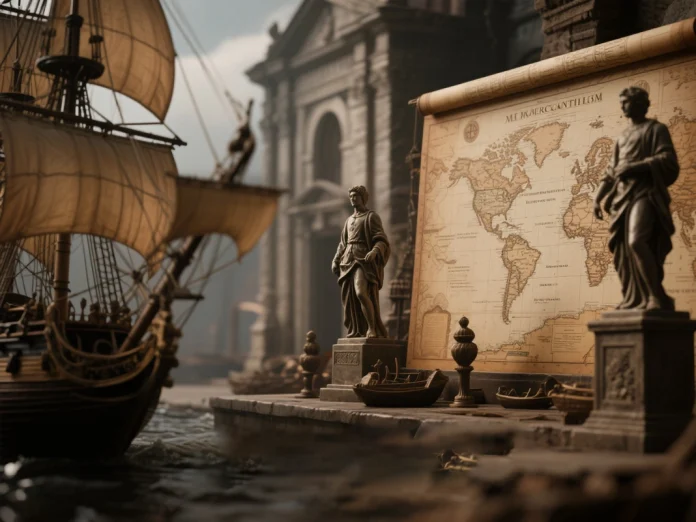Think about the great empires of the 16th to 18th centuries—Spain’s vast treasure fleets, the Dutch Republic’s global trade dominance, or the British Empire’s sprawling colonial network. What was the secret to their immense power and wealth? It wasn’t just superior armies or clever diplomacy. The real force behind these empires was a revolutionary economic doctrine known as mercantilism.
Mercantilism wasn’t just a theory; it was a way of life, a set of economic policies that transformed nations from feudal societies into global powerhouses. This system, which dominated for centuries, fundamentally reshaped world trade, ignited a new age of exploration, and ultimately laid the groundwork for the modern capitalist world.
What is Mercantilism? The Basics of the Zero-Sum Game
At its core, mercantilism is a nationalistic economic policy designed to maximize a nation’s wealth and power. The central idea is simple, if a bit ruthless: the world’s wealth is finite. To get rich, your country must take from others. This is the essence of a “zero-sum game,” where one nation’s gain is another’s loss.
To achieve this goal, mercantilist states focused on two primary objectives:
- Export more, import less. The goal was to create a “favorable balance of trade,” selling more goods to foreign countries than you bought from them. This was seen as the primary way to bring a steady stream of gold and silver—the ultimate measures of wealth—into the national treasury.
- Accumulate bullion. The more gold and silver a country held in its vaults, the more powerful it was considered. This bullion could be used to fund armies, build navies, and finance a larger, more ambitious state.
This focus on hoarding precious metals is often called bullionism, and it drove many of the era’s most significant actions, from the Spanish obsession with New World gold to the constant military conflicts between European powers.
How Did Mercantilism Actually Work?
Mercantilist policies weren’t just abstract ideas. They were a concrete set of government regulations designed to protect and grow a nation’s economic interests. Here’s how it played out in practice:
1. Protectionism and Tariffs. To keep money at home, governments slapped high tariffs (taxes) on imported goods. This made foreign products more expensive, encouraging citizens to buy domestically produced goods. For example, France might impose a heavy tax on British textiles to support its own weaving industry.
2. Colonial Exploitation. The colonies were not seen as independent entities but as economic tools. Their purpose was twofold: to supply the “mother country” with cheap raw materials (like sugar, cotton, and timber) and to serve as a captive market for finished goods. The infamous British Navigation Acts, which required all colonial trade to be carried on British ships, are a perfect example of this. The colonies were forbidden from trading with other nations, ensuring all profit flowed back to London.
3. State-Sponsored Monopolies. Governments often granted exclusive rights to powerful trading companies, such as the British East India Company and the Dutch East India Company. These monopolies had vast power, including the authority to raise armies, wage war, and govern vast territories, all in the name of securing trade routes and resources for their home nation.
4. Subsidies and Bounties. To encourage domestic manufacturing and export, governments would offer subsidies (financial aid) to certain industries. This might include paying bounties to shipbuilders or manufacturers to help them produce goods at a lower cost, making their products more competitive in the international market.
The Consequences: The Good, the Bad, and the Ugly
Mercantilism had profound and lasting effects on the world.
- Fueled Exploration and Colonization. The race for new sources of wealth—gold, silver, and valuable raw materials—was a major driver of the Age of Exploration. Nations scrambled to establish colonies, not for settlement, but for economic gain.
- Ignited Wars. The belief that one nation’s gain was another’s loss created a climate of intense competition and hostility. Wars were fought not just over land, but over trade routes, colonial possessions, and access to resources. The Anglo-Dutch Wars and the Seven Years’ War were, at their heart, conflicts over economic supremacy.
- Built Powerful States. By centralizing economic power, mercantilism helped European monarchs and governments consolidate their authority. The wealth brought in through trade and taxation allowed them to build professional armies and navies, further strengthening the state and allowing them to project their power globally.
- Paved the Way for Capitalism. While restrictive, mercantilist policies did spur innovation and domestic production. They helped establish the infrastructure for modern economies, including banking systems and large-scale manufacturing.
The Decline of Mercantilism
By the late 18th century, the system began to crumble. The rise of new economic thinkers, most notably Adam Smith, challenged its core assumptions. In his groundbreaking work The Wealth of Nations (1776), Smith argued that wealth was not finite. Instead, he proposed that free trade and specialization would allow all nations to grow richer. He saw protectionism and monopolies as hindrances, not engines, of true wealth.
Smith’s ideas, combined with growing discontent in the colonies (culminating in the American Revolution, a direct result of mercantilist restrictions), led to the gradual shift towards a new era of free-market capitalism.
In the end, mercantilism was the dominant economic engine of its time. It created unprecedented wealth for some, but at the cost of intense conflict and the exploitation of millions. Its legacy is a complex one, a reminder of how economic ideas, both good and bad, can shape the course of history and forge the empires that still define our world today.



